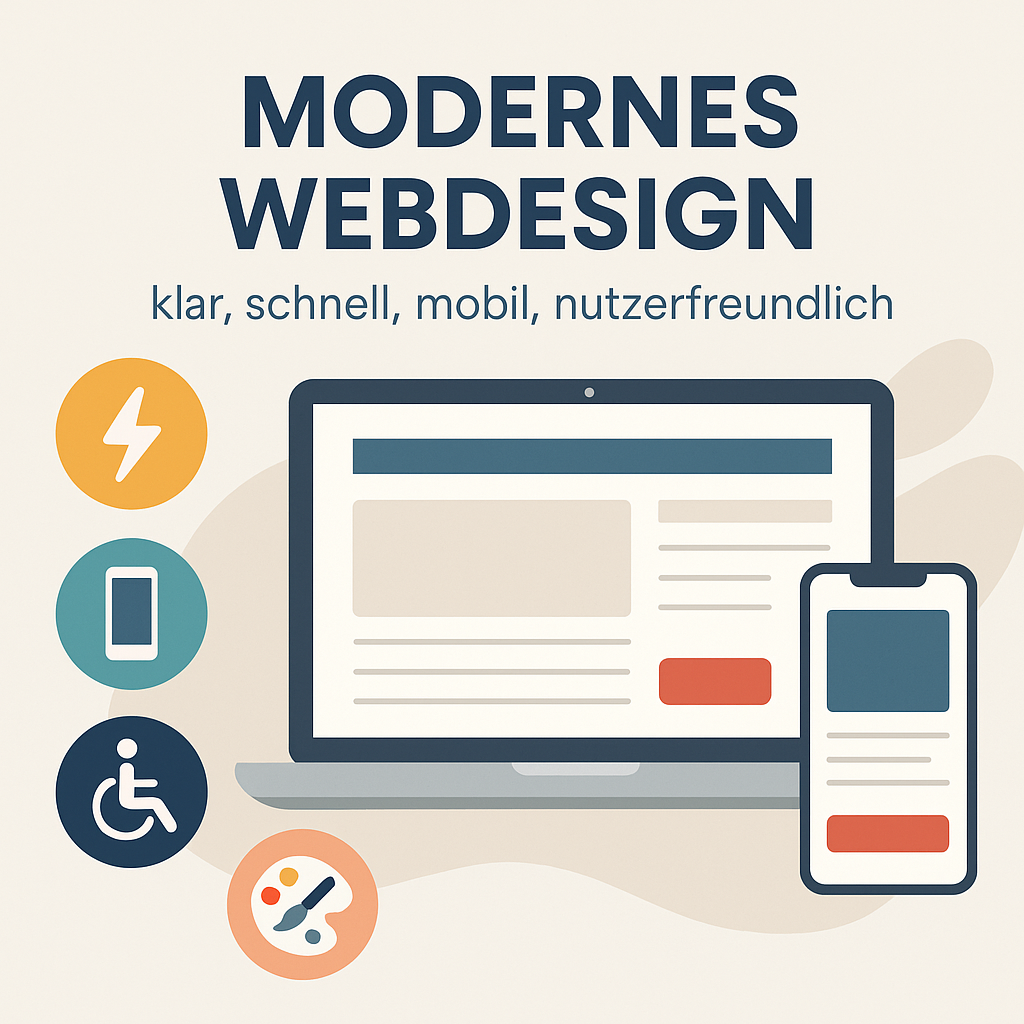Today, your website is the most important point of contact for many customers. It provides information, conveys trust and often decides whether someone is interested in your company or immediately leaves. One thing is clear: outdated sites with slow loading times, confusing structures or a look from the 2000s no longer stand a chance.
But what exactly is modern web design? And why should you focus not only on the external appearance, but above all on the experience of your users? In this article, you will find out which features characterize modern websites, why they are more than just beautiful design and how to approach a successful relaunch or redesign.
Features of modern websites
Modern web design doesn't mean that everything has to look futuristic. Rather, it's about your website being clear, fast, mobile-friendly, accessible and brand-appropriate.
Clarity
Visitors don't have time to click through chaos. A clear structure with intuitive navigation, clear headings and precise text ensures that content is quickly understood. Less is often more here.
Speed
A modern website loads in seconds. Slow loading times put users off and worsen your Google ranking. Compressed images, optimized code and strong hosting are mandatory.
Mobile friendliness
Over 70 percent of website visits today are mobile. Responsive design is therefore not an option, but a standard. Content must work just as well on a smartphone as it does on a desktop.
Accessibility
The legal obligation for digital accessibility has been in force since 2025. Modern websites are designed in such a way that they can be used by everyone, including people with visual, hearing or motor impairments. Clear contrasts, alternative texts and ease of use are basics that also benefit all other visitors.
Corporate Identity
Colors, fonts and imagery are more than just decoration. They convey your brand and create recognition. A modern website only looks coherent if the design and brand identity fit together.
Why modern web design is not an end in itself
It's not about chasing every trend. Modern web design is a tool to improve the customer experience.
Imagine someone searches for your service and lands on a confusing, old website. Before they even read your offer, their trust is gone.
A modern website, on the other hand, looks professional, up-to-date and trustworthy. It guides visitors intuitively to the right information and makes the next step, such as an inquiry, purchase or booking, as easy as possible.
This has concrete advantages:
- More trust: A well-maintained website conveys seriousness
- Longer dwell time: Those who understand content quickly stay longer
- More conversions: clear user guidance brings more inquiries and sales
- Better visibility: Fast, low-barrier and mobile-friendly pages perform better on Google
In short: modern web design not only brings aesthetics, but real results.
Relaunch or redesign - when is it time?
Many companies ask themselves: Do we need a completely new website or is a facelift enough? Here are a few questions to help you decide:
- Is your website loading slower than three seconds?
- Does it work smoothly on the smartphone?
- Is your content up-to-date and target group-oriented?
- Does the design reflect your brand?
- Are there clear calls to action (CTAs)?
- Is the site barrier-free?
If you think no to several questions, a relaunch or at least a redesign is due.
Tips for your relaunch or redesign
To ensure that your new website not only looks pretty, but is also successful in the long term, you should consider the following points:
1. start analysis
Check how your current page is performing. Loading times, bounce rates, conversion rates and keyword rankings give you important information. Tools such as Google Analytics or Matomo help with the analysis.
2. define goals
Think about what you want to achieve with your new site: More inquiries? Greater visibility? A more modern brand image? Without clear goals, you will quickly get lost in the details.
3. revise contents
Update texts, tighten structures and build clear messages. Always write from the perspective of your target group. What questions do they have, what problems do they want solved?
4. optimize user guidance
Visitors should reach their destination with just a few clicks. Place visible calls to action, pay attention to logical click paths and avoid unnecessary hurdles.
5. update technology
An up-to-date CMS such as WordPress, secure plugins, GDPR-compliant tools and regular updates are mandatory. This not only protects you from technical problems, but also from warnings.
6. do not forget testing
Test the new site on different devices, browsers and screen sizes. Errors are best noticed before the site goes live.
Conclusion: Modern web design means user-friendliness
A modern website is not a luxury, but a standard. It is clearly structured, fast, mobile-friendly, accessible and fits your brand perfectly. Above all, however, it focuses on people: your visitors.
If you regularly analyze your site, consciously modernize it and keep your target group in mind, you will not only create an attractive website, but also a customer experience that has a lasting effect.
Are you wondering whether your current website is still up to date or whether it's time for a relaunch?
Then let's take a look together and take your brand to the next level digitally.
Request a non-binding initial consultation with Kontraste now!

